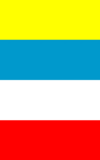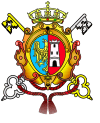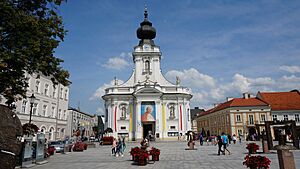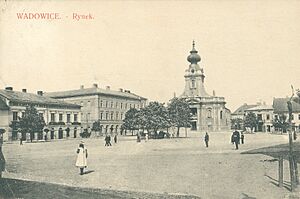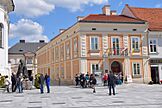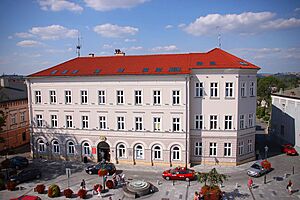Wadowice facts for kids
Quick facts for kids
Wadowice
|
|||
|---|---|---|---|
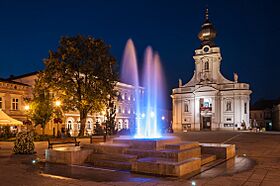
View of the Main Square
|
|||
|
|||
| Country | |||
| Voivodeship | Lesser Poland | ||
| County | Wadowice | ||
| Gmina | Wadowice | ||
| First mentioned | 14th century | ||
| Town rights | 1430 | ||
| Area | |||
| • Total | 10.52 km2 (4.06 sq mi) | ||
| Highest elevation | 318 m (1,043 ft) | ||
| Lowest elevation | 250 m (820 ft) | ||
| Population
(2022)
|
|||
| • Total | 17,455 | ||
| • Density | 1,659.2/km2 (4,297.4/sq mi) | ||
| Time zone | UTC+1 (CET) | ||
| • Summer (DST) | UTC+2 (CEST) | ||
| Postal code |
34–100
|
||
| Area code(s) | +48 33 | ||
| Car plates | KWA | ||
| National roads | |||
| Website | http://www.wadowice.pl | ||
Wadowice is a town in southern Poland. It is located about 50 kilometers (31 miles) southwest of Kraków. The town has about 17,455 people living there (as of 2022). Wadowice sits on the Skawa river, which flows into the Vistula river. It is famous for being the birthplace of Karol Wojtyła, who later became Pope John Paul II. Another notable person from Wadowice was Godwin von Brumowski, a top flying ace from Austria-Hungary during World War I.
Contents
The History of Wadowice
Wadowice has a long and interesting history. The first people settled here around the late 900s or early 1000s.
How Wadowice Began
Local stories say the town was founded by someone named Wad or Wład. This name is a short form of the Slavic name Ladislaus. The town was first written about as Wadowicze in church records between 1325 and 1327. It was also mentioned in a record sent from Prince John I Scholastyk to the Bohemian king in 1327. At that time, Wadowice was a trading settlement. It belonged to the Dukes of Silesia. Some historians believe it was already a town back then.
In 1430, a big fire destroyed Wadowice. But the town was quickly rebuilt. It was then given special "city rights" by Prince Kazimierz I of Oświęcim. These rights allowed the town to govern itself, which helped it grow quickly.
Wadowice in the Past: Changes and Growth
The region's borders changed a lot over time. Wadowice first belonged to the Duchy of Oświęcim. Then, after 1445, it became part of the Duchy of Zator. For a short time, there was even a separate Duchy of Wadowice. In 1494, the King of Poland bought the Duchy. Wadowice then became part of the Kraków Voivodeship in 1564.
During the 1500s and 1600s, Wadowice was a center for crafts and trade. A famous person from Wadowice was Marcin Wadowita. He was a smart thinker and teacher at the Kraków Academy. He also started a hospital and a school in Wadowice. However, several sicknesses and fires slowed down the town's growth.
Wadowice in Modern Times
In 1772, Wadowice became part of Austria. Its name was changed to Frauenstadt. The town started to grow again after a new road was built connecting Vienna with Lviv. Wadowice became an important local center. It had its own government and, later, became a county seat. Small factories started to appear in the 1800s. Many new people moved to the area. They were drawn by the jobs in factories, new army buildings, and government offices. A new hospital and a court were also built. Later in the 1800s, people in Austria-Hungary gained more freedom. This led to the creation of many Polish cultural and science groups in Wadowice.
After World War I, Poland became an independent country again. Wadowice remained a county town. In 1919, people from the area formed an army regiment that fought in the Polish–Soviet War. In 1920, Karol Wojtyła was born in Wadowice. He later became the Bishop of Kraków and then Pope John Paul II.
Wadowice During World War II

During World War II, Germany took over Poland in 1939. Wadowice was annexed by Nazi Germany. Its name was changed to Wadowitz. The German rulers targeted Polish teachers, priests, and artists. Many were killed in mass executions. Hundreds more were forced to leave their homes to make room for German settlers.
A Nazi prison was set up in Wadowice. Between 1941 and 1943, a ghetto was created for Jewish people. Sadly, almost all of the more than 2,000 Jewish people from Wadowice were killed. Most of them died in the nearby Auschwitz concentration camp. The Germans also had a prisoner-of-war camp for Allied soldiers and a camp for prisoners who were being sent to other concentration camps.
Despite the harsh German rule, Polish resistance groups were active in the area. After the war, Wadowice returned to Poland.
Wadowice Today
After World War II, Wadowice kept its status as a county town. It was an important center for trade and transport until 1975. After Poland became a democratic country in 1989, many local factories closed. However, Wadowice's beautiful natural surroundings and its connection to Pope John Paul II helped tourism grow quickly. Today, more than 200,000 people visit Wadowice every year. This number continues to rise.
Wadowice's Economy
Today, Wadowice is mostly a center for tourism and sightseeing. It also has some smaller industries. These include making machines and building materials. Wadowice is home to the main office of Maspex, a large food company and Poland's biggest juice maker. The shoe company Badura also has its headquarters here.
Culture and Fun Things to See
- Days of Wadowice (Dni Wadowic) are celebrated every May and June. The celebration starts on May 18th. This day remembers the birthday of Karol Wojtyła.
- Museum of the Holy Father Family Home is in the house where Pope John Paul II grew up. It has items that belonged to him and his family.
- Parochial Church – This is the Virgin Mary's Offertory minor basilica. It was built in the 1400s and rebuilt in the 1700s.
- Kościelna 4 street – An old house from the 1700s.
- Neo-Classical "Mikołaj" Manor – This manor house from the 1800s is named after a former mayor, Mikołaj Komorowski.
- Municipal Museum of Marcin Wadowita – A museum dedicated to the famous local scholar.
- Pope John Paul II Square – The main square of the town, surrounded by houses from the 1800s.
- Monument to Emil Zegadłowicz – A statue honoring a writer who wrote many books about the Wadowice area.
Religion in Wadowice
- Roman Catholicism (Basilica)
- Jehovah's Witnesses (Kingdom Hall)
Sports in Wadowice
The most well-known sports club in Wadowice is Skawa Wadowice. It has teams for football, basketball, volleyball, and tennis. Founded in 1907, it is one of the oldest sports clubs in the region.
Twin Towns and Sister Cities
Wadowice has friendly connections with several other towns around the world. These are called "twin towns" or "sister cities":
 San Giovanni Rotondo in Italy (since 2006)
San Giovanni Rotondo in Italy (since 2006) Pietrelcina in Italy (since 2006)
Pietrelcina in Italy (since 2006) Carpineto Romano in Italy
Carpineto Romano in Italy Sona in Italy
Sona in Italy Canale d'Agordo in Italy (since 2010)
Canale d'Agordo in Italy (since 2010) Marktl in Germany
Marktl in Germany
Famous People from Wadowice
- Marcin Wadowita (1567–1641), a Polish thinker and teacher.
- Godwin von Brumowski (1889–1936), a top fighter pilot from Austria-Hungary in World War I.
- Raphael Kalinowski (1835–1906), who helped found a college, seminary, church, monastery, and convent in Wadowice.
- Ada Sari (1886–1968), a famous Polish opera singer and actress.
- Karol Wojtyła (1920–2005), who became Pope John Paul II.
- Anna Plichta (born 1992), a racing cyclist.
See also
 In Spanish: Wadowice para niños
In Spanish: Wadowice para niños


